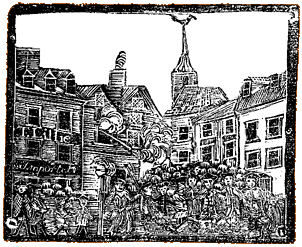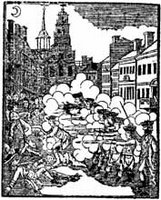
Only a very small fraction of people alive in 1775 ever had their portraits professionally painted or drawn. John Adams was one of those few. In fact, because he became so prominent in the Revolutionary War and early American republic, we have many portraits of him over several decades. Those images let us watch him mature—and watch changes in how gentlemen presented themselves.
Lawyer John Adams bought pastel portraits of himself and his wife Abigail from
Benjamin Blyth about 1766, when he was thirty-one years old. These pictures are small, and the medium was less expensive and prestigious than oil paintings. But buying portraits at all showed how the Adamses sought to fit into a genteel and sophisticated level of society. John's plump, unwrinkled face looks out from under the bushy white powdered wig of an attorney, perhaps trying not to smile too proudly. This portrait and its mate are displayed by the
Massachusetts Historical Society in Boston.
When he was involved in politics before and during the Revolutionary War, Adams had less time to sit for artists. But he grew prominent as an American statesman and diplomat, becoming the sort of man whose portrait other people asked for. In Europe, painters were better trained and more numerous than in colonial America, but the artists who took Adams's likeness were all American expatriates, many of them Loyalist. (Benjamin Franklin, in contrast, was highly popular with French artists.)
In 1783, when Adams was in London helping to negotiate the end of the Revolutionary War, Boston-born artist
John Singleton Copley painted a full-length portrait of him—the most elaborate he ever posed for. In this painting Adams gestures to maps and a globe, symbols of the treaty he had just negotiated. Copley's original is now owned by
Harvard University. The
Metropolitan Museum of Art in New York owns Copley's sketch of Adams in this pose.
Another interesting image from this period is
Benjamin West's unfinished painting of the commissioners who negotiated the Treaty of Paris in 1783. All five of the American diplomats posed for West, but the British ministers chose not to, and the painting was never finished. It now hangs at the
Winterthur Museum in Wilmington, Delaware, which has more beautiful things than it can possibly display. The
U.S. State Department offers online visitors a closer look at a copy of West's painting; Adams is seated to the left.
The
Boston Athenaeum has a fine portrait of Adams by
Mather Brown, a British court painter born in Boston, from around the same time.
Connecticut artist
John Trumbull painted Adams in 1793, when he was Vice President. In this image Adams looks remarkably placid, which to me means it's not a very good likeness. This may have been the statesmanlike calm that Adams wanted to exude, but he rarely achieved that demeanor in his writings or his discussions with other people; that's what makes him so interesting. This portrait was donated to
Harvard by merchant Andrew Craigie, then the owner of
Longfellow House in Cambridge. A similar portrait is in the
National Portrait Gallery in Washington.
Trumbull also included Adams, as he imagined him looking about twenty years before, in his monumental "Declaration of Independence" for the
U.S. Capitol. (In fact, despite writing about his care for accuracy, Trumbull seems to have
imagined quite a bit about that painting.)
In the same period, Adams sat for Philadelphia artist
Charles Willson Peale. This portrait is at
Independence National Historic Park, but for a full-color web preview we have to go
elsewhere. The vice president had started to wear his hair (what he had left) in a different style. Adams still had his hair curled and dressed, but he had stopped wearing a wig. Republican values had made the powdered wigs of his earliest portraits unfashionable.
Silhouettes and profiles were fashionable during Adams's administration. Around 1800, the French emigré artist
Charles Balthazar J. F. Saint-Mémin drew a "grayscale" profile of the president in crayon, charcoal, and chalk. Saint-Mémin used a physiognotrace, a device that made it easy to trace a person’s silhouette onto paper and thus to create a close, if somewhat stiff, likeness now at the
Metropolitan Museum of Art. (The
Smithsonian offers more information about Saint-Mémin.
Wendy Bellion at MIT discusses his physiognotrace and similar inventions.)
Around the same time,
Raphaelle Peale, one of the many sons of Charles Willson Peale, reportedly produced the silhouettes of John and Abigail Adams in the
Peale Family Papers.
Gilbert Stuart painted Adams starting around 1800, in the final years of his presidency. This was one of the most bitter periods of Adams's life, analyzed by Joseph Ellis in
Passionate Sage. I see a little of that shock and suspicion in Adams's face. As he did with his famous portrait of George Washington, Stuart kept working on his original while he produced several copies for sale to other customers. This painting can be viewed at the
National Gallery in Washington, DC.
Stuart used his original to paint Adams in an uncharacteristically bright red suit for one of a series of presidential portraits, also at the
National Gallery. In this image, I think the ex-president's face looks a bit more relaxed. Though Stuart was still working from his original sketches, in an odd way this later portrait manages to depict Adams after he had made peace with his electoral defeat.
Stuart returned to Adams in 1823 and painted another portrait of the former president as he neared ninety. He was obviously a man in retirement, no longer dressing his hair or dressing up. His face had developed more wrinkles. He was now a widower, Abigail having died in 1818. But his expression exudes intellectual vigor. This image is at the
Museum of Fine Arts in Boston.
French sculptor
J. B. Binon created a bust of Adams for Boston's
Fanueil Hall around 1818. It was thought to be a good likeness, which makes me think how portly the ex-president must have been at this time. Plaster copies were sold to admirers, and Thomas Jefferson's is on display at
Monticello. This is the irascible face that greeted some visitors to Adams's house in Braintree.
One of my favorite images of John Adams—indeed, one of my favorite manmade objects in the world—is the bust of the ex-President created by sculptor
J. H. I. Browere in 1825. It's on display at the New York State Historical Association's
Fenimore House Museum in Cooperstown, New York, alongside similar busts of Thomas Jefferson, John Quincy Adams, Henry Clay, and other American notables of that decade. (See the photo above.)
Because Browere developed his bust from a life mask—a plaster cast of Adams's actual face—it's remarkably vivid. You can see how the president had lost some teeth on the right side of his mouth, for instance. (That may be why Stuart put that side of his face in shadow in his 1823 painting.) Overall, the face is so lively that looking at the bust feels almost like visiting the old man himself. Seeing these busts is worth the trip to Cooperstown, which is a beautiful place, anyway.
C-SPAN offers an expensive video on this collection. All the books about it have gone out of print.
Finally, there have been many posthumous depictions of Adams, all necessarily based on the paintings and sculptures above. Some of the notable ones:
ADDENDUM:
Another John Adams portrait, this one by Samuel F. B. Morse.








